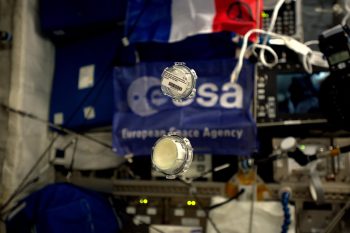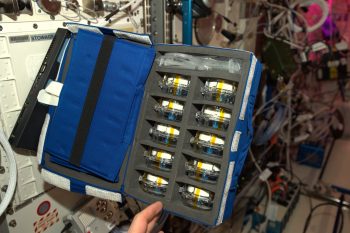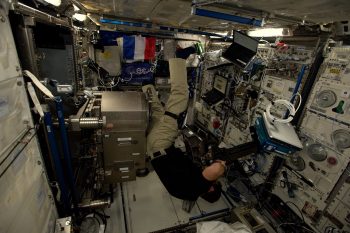Thomas Pesquet has spent two weeks in his new home the International Space Station. We will look at what he has done and look at the week to come later on. Every day all astronauts have lunch, dinner, daily planning conferences and exercise for two hours these activities will not be mentioned every time.
Our astronaut’s first task in space was a safety briefing that all new arrivals get on the Station’s systems. His first experiment was the Fine Motor Skills experiment that is charting how his body adapts to space through a simple test on a tablet. The dexterity of the test subjects is tested using software that tests their speed, response time and accuracy.
Week 1
Monday 21 November
On Monday 21 November Thomas took some blood samples and stored them , did another session for Fine Motor Skills and prepared for the arrival of the Cygnus supply spaceship. After lunch Thomas placed some accoustic monitors to record sound levels in the Station and relayed some cables. He did his daily dose of exercise on the T2 treadmill and installed the Matiss experiment in European space lab Columbus to see how different materials resist bacterial growth.

AquaPad. Credits: ESA/NASA-Thomas Pesquet
Tuesday 22 November
On Tuesday Thomas sampled the Space Station’s water to make sure the water was safe to drink as well as getting some water to test a new system for the Aquapad experiment. Thomas was introduced to the Station’s bicycle exercise system and the workout machine ARED and had some mandatory emergency drills. Before going to bed he downloaded some data for the Marrow experiment.

Rangement avec le commandant Shane et Peggy. Credits: ESA/NASA-Thomas Pesquet
Wednesday 23 November
Wednesday was spent with more “crew orientation” for new arrivals, working in the Japanese Kibo laboratory packing items and exercise. In the afternoon Thomas had his press conference with ESA more emergency drills and a private medical conference to perform an eye exam with commander Shane Kimbrough.
Thursday 24 November
After the morning conference with ground control Thomas read a story for children for a NASA outreach project. The rest of the day was spent working to repair the Station’s toilets and maintain the water condensation system that recycles the water in the air.

Les échantillons AquaPad. Credits: ESA/NASA-Thomas Pesquet
Friday 25 November

Installation de la machine MARES. Credits: ESA/NASA-Thomas Pesquet
On Friday Thomas did another Fine Motor Skills session and analysed the AquaPad results from Tuesday. He spent more time working on the toilet, gathered some items that will be trashed on a future supply spacecraft, had another orientation session and started to prepare the Mares machine for the Sarcolab-3 experiment from the CADMOS team. In the afternoon he did an eye ultrasound for general health data and swapped a hard disk in a laptop used for Earth observation.
Saturday 26 November
Saturday is cleaning day on the International Space Station as the whole six-member crew get to work to keep their home and workplace clean. Sunday is a day off.
Week 2
Monday 28 November
Thomas second week in orbit started with taking blood samples and storing them in the –80°C freezer before exercising and then talking to schoolchildren in France via radio. Afterwards he collected and stored his urine in the freezer for later analysis and then started on the Sarcolab-3 experiment that would take up most of his week. Sarcolab-3 is one of the most complex experiments for the Proxima mission. It will study the adaptation of the muscle function in microgravity. The focus is on the ankle and the knee joints.
Tuesday 29 November
On Tuesday Thomas did another Fine Motor Skills and Marrow session before working with Mares all morning doing the ankle measurements for Sarcolab-3. In the afternoon he worked more on the toilet and did his daily exercise.
Wednesday 30 November

Thomas on MARES for the Sarcolab-3 experiment, supported by Russian colleague Sergey Ryzhikov. Credits: ESA/NASA-Thomas Pesquet
Thomas started Wednesday 30 November with Mares doing the knee measurements for Sarcolab-3 and together with Peggy measured their bodies to keep track of how they are changing in life in microgravity. In the afternoon Thomas inspected a hatch in Node-3 for general maintenance and had a video-link with French news TF1 that would be broadcast later that evening.

Electromagnetic levitator. Credits: DLR
Thursday 1 December
On Thursday Thomas started work rerouting cables in Jaxa’s Kibo laboratory and continued inspecting a hatch. He started preparing for the arrival of the Japanese supply spacecraft HTV and with work on Mares finished started to pack the machine. In the afternoon he helped Shane with an experiment involving the Spheres droids and worked on the European Magnetic Levitator.
Friday 2 December
Friday morning Thomas spent cleaning, preparing and running a session in the Japanese Electrostatic levitation furnace. In the afternoon he was given instructions by commander Shane on the Space Station’s general operations.
THIS WEEK (5 December – 9 December 2016)
Highlights for Thomas for the week of 5 December include starting the French EveryWear experiment that aims to simplify astronaut life in space, using ultrasounds for the Cardio Ox and Vascular Echo experiment. Thomas will continue to wear a personal dosimeter that measures the dose of radiation he absorbs. There are five mobile dosimeters that Thomas swaps while the other ones charge.
He will continue with Fine Motor Skills, prepare for HTV to arrive, maintain the Space Station’s air monitor and talk live with an event for the ‘Académie des Sciences’ in Paris.





Discussion: one comment
Fascinating and fantastic to be able to follow this and learn about the challenges and varied research on the ISS, with application to both space travel and life on earth.